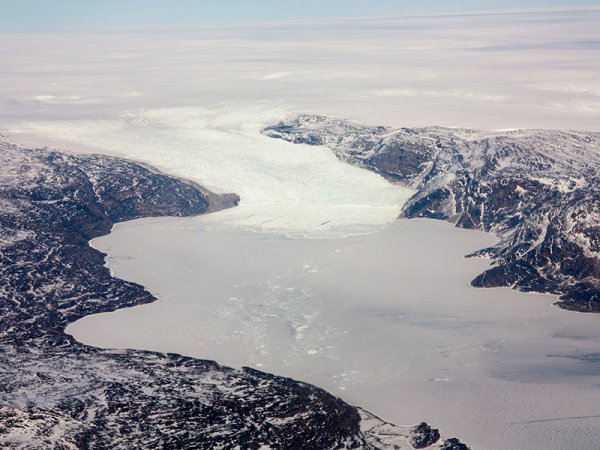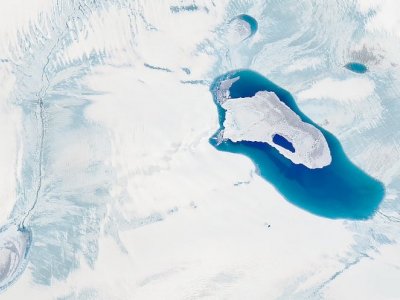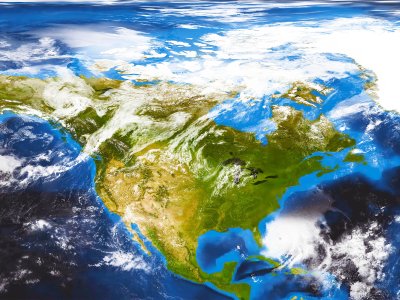Luke Trusel, an assistant professor in the Department of Geography, and Jessica Preller, a doctoral student in the Department of Geography and Trusel’s Cryosphere and Climate Lab, are Arctic researchers. Their expertise includes sea ice, climate, and the relationship between the two. With numerous stories in the news about Arctic ice melting and glaciers collapsing (e.g., the cover image for this blog is a photo take by Trusel showing a glacier draining from the Greenland ice sheet flows into a sea ice and iceberg-filled fjord), we asked Trusel and Kromer about warming in the Arctic and what it means for the future.
Why is the Arctic warming?
The Arctic has been warming since at least 1900, but temperature increases have been particularly rapid over the last 50 years. This period coincides with broader, accelerated global warming trends and is the direct result of human emissions of greenhouse gases. Quite simply, we cannot account the observed warming trends without also considering the effects of anthropogenic greenhouse gas emissions.
Why is the Arctic warming two to three times faster than other areas in the world?
The Arctic is made up of mostly ocean, which typically is covered by sea ice. Since the late 1970s, observations have shown rapid decline in sea ice. The loss of sea ice means more open water for a longer period. Sea ice is bright and reflective while the ocean is dark and absorbs more energy from the sun. That heat is then stored in the upper layer of the ocean keeping more sea ice from forming and helping melt more ice, leading to more exposed ocean to absorb more heat. This fuels a continuous cycle, accelerating sea ice melt and warming in the Arctic.

How is the physical environment changing?
Among the most prominent signatures of a warming planet are decreases in the extent, thickness, and seasonal duration of the Arctic’s sea ice cover. Satellite observations reveal decreases in ice in all seasons, with the most prominent losses occurring in summer when the sea ice is at its annual minimum. This loss of sea ice accompanies profound changes across the atmosphere, ocean, and land in the Arctic. These changes include rapid atmospheric warming, widespread permafrost thaw and release of carbon, threats to natural ecosystems and human livelihoods, and melting of both land and sea ice at rates that are unprecedented over centuries or millennia.
The sea ice pack in the Arctic is not only shrinking in area, but also getting thinner as the proportion of thick, multi-year sea ice has largely disappeared in recent years. This remaining younger and thinner ice is less resilient to a warming atmosphere and ocean, thereby exacerbating the overall downward ice spiral.
Melting at the surface of Greenland’s ice sheet has accelerated over the last several decades and is outpacing only negligible changes in snowfall atop the ice sheet. In fact, meltwater runoff from the Greenland ice sheet is today likely at its highest point in the last several thousand years. As a result of this, and increased solid ice discharge into the ocean, Greenland has become a leading source of new water added to the ocean every year. Our research also highlights how the response of the ice sheet to warming is non-linear—as temperatures rise, the melting accelerates. This means that the ice sheet is far more sensitive to temperature variations now than it was just several decades ago. This of course holds particularly important implications for the future, as temperatures continue to rise, especially in the Arctic.

https://www.nature.com/articles/s41586-018-0752-4/figures/4
Research also reveals that there are likely strong connections between the state of the ocean, atmosphere, and land ice in the Arctic. Our work has illustrated that increases in Greenland ice sheet runoff initiated shortly after the onset of industrial-era warming in the Arctic and that this time also coincided with the onset of negative trends in the Arctic’s sea ice cover. The emergence of ice sheet runoff beyond the range of natural variability has only recently occurred, however, closely following the onset of the steep decline in Arctic sea ice. The coincidence of these factors suggests that Arctic sea ice loss may amplify Greenland ice sheet melt and runoff, illustrating connections between these sensitive cryosphere system components at high latitudes.
What is a warming Arctic affecting?
Loss of sea ice results in loss of habitat for animal species like polar bears and walrus. It also provides a means for increased human access to the less-frozen Arctic Ocean, which has raised new international geopolitical tensions. Loss of sea ice has afforded new opportunities for maritime trade, fishing, mineral and energy exploration, and “last chance” tourism. For example, there have been large decreases in sea ice across the Russian Arctic, allowing for the Northern Sea Route to become a viable shipping lane over the last decade. In addition, navigation through Canada’s Northwest Passage has become viable in some recent years, something that could only be dreamed of at the turn of the 20th century as European explorers embarked on expeditions of the Arctic.

What does the future look like for the Arctic?
Less white, more blue in the ocean, more green on land, and more people everywhere. The Arctic may also soon be seasonally sea ice-free during summer.
There will likely be an increased human presence in the Arctic Ocean. On one hand, this could mean reduced shipping time and thus shipping-related emissions, as well as increased access and new revenue sources for Indigenous communities in the high Arctic, but it could also bring with it the introduction of invasive species and new sources of environmental pollutants.
With increased mass losses from the Greenland ice sheet and the Arctic’s smaller bodies of land ice, there is concern about reaching a tipping point for the surface mass balance of the Greenland ice sheet, whereby annual surface meltwater runoff would exceed the replenishment via snowfall. This could then lead to runaway mass loss—or the threshold beyond which the ice sheet enters a state of irreversible mass loss—over the course of hundreds-thousands of years. Most fundamentally, however, the rate and magnitude of Greenland ice sheet contributions to sea level rise are directly tied to the rate of warming experienced and thus the anthropogenic emissions of greenhouse gases.
Most directly, the future of the Arctic depends to a large extent on the emissions pathways that play out over the next few decades.
What does a warming Arctic mean for areas in North America (for example)?
One of the more significant effects a warming Arctic has had on North America is through the weakening of the jet stream. When the atmosphere in the Arctic is warmed, the temperature difference between the polar region and mid-latitude regions, such as North America, is lessened. This results in a less stable, wavy jet stream and atmospheric blocking (e.g., polar vortex) that has brought recent severe weather events to North America including intense snowstorms across the Northeastern US, severe drought over the Western US, or harsh cold spells across the US, such as the deep freeze in Texas last year.
Why should people be aware of Arctic warming and learn more?
What happens in the Arctic does not stay in the Arctic – the impacts of Arctic change are profound and widespread.
How can the average person make a difference?
Education and advocacy. Voting with ballots and wallets.






